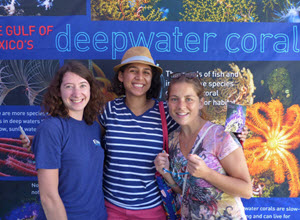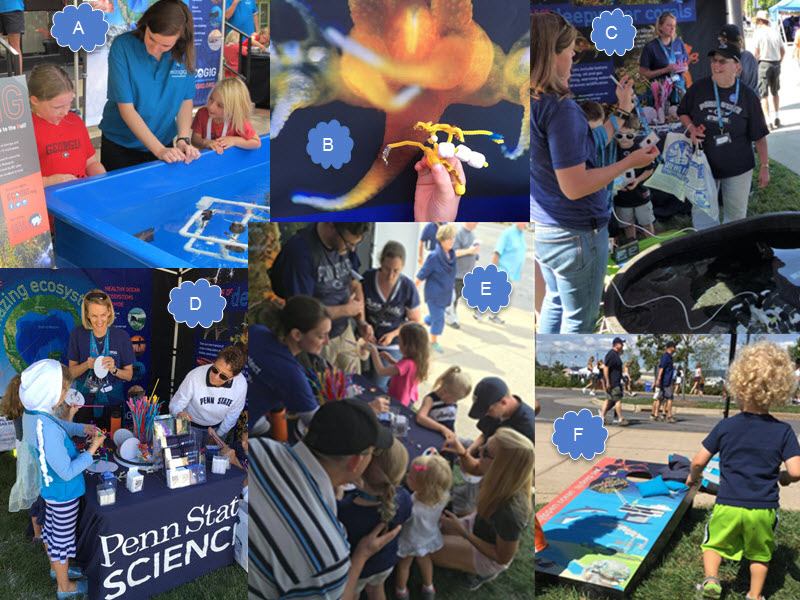
Graduate student Fanny Girard (left) joins game-day fans at the ECOGIG-II Ocean Discovery Zone. The coral banner makes a beautiful photo backdrop! (Photo by ECOGIG-II)
Scientists and education staff have tapped into a novel venue – football games – to reach new audiences and share ongoing research and ocean technology. The research consortium Ecosystem Impacts of Oil and Gas Inputs to the Gulf II (ECOGIG II), funded by the Gulf of Mexico Research Initiative (GoMRI), took their mobile Ocean Discovery Zone on the road to State College, PA for the Penn State Nittany Lions season opener.
“Football is a passion for people around the country, and a remarkable number of people fill stadiums every Saturday in the fall,” explained Sara Beresford, the Communications and Outreach Lead for ECOGIG-II, on why they chose this venue. “Hosting our exhibit during tailgating, we’re able to interact with and reach people who might not otherwise seek out the information we can provide.”
Visitors can drive a model Remotely Operated Vehicle (ROV) to learn about an important piece of technology used in deep ocean research. Visitors also can build deepwater corals, see a model of a natural hydrocarbon seep, and view video content and information displays about the Gulf and deepsea exploration. Game-day fans can attend four more Ocean Discovery Zone events in the southeast this year.

A: Graduate student Sarah Harrison explains to young fans how scientists use ROV (Remotely Operated Vehicle) technology. Visitors can drive the model ROV and earn honorary ECOGIG Pilot’s Licenses. B: A coral enthusiast built a replica of the deepwater coral polyp displayed on one of our tent sidewalls. C: Pen State fans used the ROVs to collect replications of deep sea animals from the bottom of the tank and learned about life in the deepest parts of the Gulf of Mexico. D: ECOGIG education and outreach lead Sara Beresford helps fans build deepwater corals to take home. This station was quite popular with everyone! E: Pen State fans used the ROVs to collect replications of deep sea animals from the bottom of the tank and learned about life in the deepest parts of the Gulf of Mexico. F: This young fan enjoyed playing Gulf of Mexico themed cornhole! (All Photos by ECOGIG-II)
“For me, the most exciting part of the program is the opportunity to engage with visitors – both children and adults – and share stories with them about our work and its relevance for the Gulf of Mexico and the global oceans,” said Dr. Samantha Joye, the Director of ECOGIG-II. “I’m always impressed by the questions I’m asked and by the enthusiasm I see, especially in young people. Seeing these young kids get inspired and start asking thought-provoking questions about the Gulf of Mexico and oceans in general is really special.”
Fans met several scientists at Penn State, including ECOGIG-II co-Principal Investigators Dr. Charles Fisher and Dr. Iliana Baums, and learned about their research on the unique deepwater coral communities in the Gulf.
Want to join the fun? The 2016 Science in the Stadium schedule is available here.
Read more about ECOGIG II and their research on their website and Facebook page.
Read about last year’s events at What a Matchup! SEC Football and Science at the Stadium.
************
The GoMRI is a 10-year independent research program established to study the effect, and the potential associated impact, of hydrocarbon releases on the environment and public health, as well as to develop improved spill mitigation, oil detection, characterization and remediation technologies. An independent and academic 20-member Research Board makes the funding and research direction decisions to ensure the intellectual quality, effectiveness and academic independence of the GoMRI research. All research data, findings and publications will be made publicly available. The program was established through a $500 million financial commitment from BP. For more information, visit http://gulfresearchinitiative.org/.
